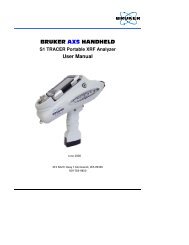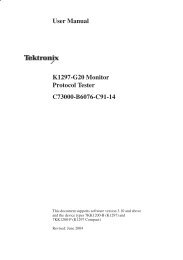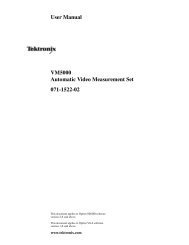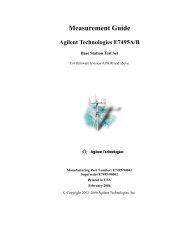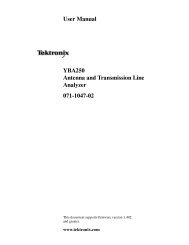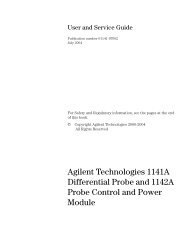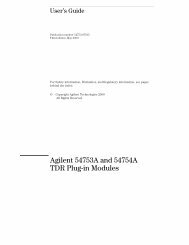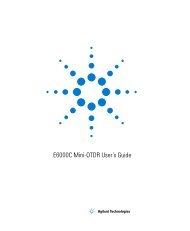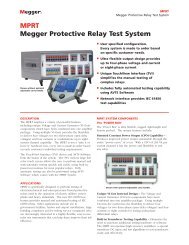Agilent E8257D PSG Analog Signal Generator - MetricTest
Agilent E8257D PSG Analog Signal Generator - MetricTest
Agilent E8257D PSG Analog Signal Generator - MetricTest
Create successful ePaper yourself
Turn your PDF publications into a flip-book with our unique Google optimized e-Paper software.
<strong>Agilent</strong> <strong>E8257D</strong> <strong>PSG</strong><br />
<strong>Analog</strong> <strong>Signal</strong> <strong>Generator</strong><br />
Data Sheet<br />
The <strong>Agilent</strong> <strong>E8257D</strong> is a fully synthesized signal generator with high output power,<br />
low phase noise, and optional ramp sweep capability.<br />
Specifications apply over a 0 to 55 °C range, unless otherwise stated, and apply<br />
after a 45 minute warm-up time. Supplemental characteristics, denoted as<br />
typical, nominal, or measured, provide additional (non-warranted) information<br />
at 25 °C, which may be useful in the application of the product.<br />
Definitions<br />
Specifications (spec): Represents warranted performance for instruments with a<br />
current calibration.<br />
Typical (typ): Represents characteristic performance which is non-warranted.<br />
Describes performance that will be met by a minimum of 80% of all products.<br />
Nominal (nom): Represents characteristic performance which is non-warranted.<br />
Represents the value of a parameter that is most likely to occur; the mean and/or mode of<br />
all measurements of a parameter.<br />
Measured: Represents characteristic performance which is non-warranted. Represents<br />
the value of a parameter measured on an instrument during design verification.
Table of Contents<br />
Specifications . . . . . . . . . . . . . . . . . . . . . . . . . . . . . . . . . . . . . . . . . . . . . . . . . . . . . . . . . . . . .3<br />
Frequency . . . . . . . . . . . . . . . . . . . . . . . . . . . . . . . . . . . . . . . . . . . . . . . . . . . . .3<br />
Step (digital) sweep . . . . . . . . . . . . . . . . . . . . . . . . . . . . . . . . . . . . . . . . . . . . .4<br />
Ramp (analog) sweep . . . . . . . . . . . . . . . . . . . . . . . . . . . . . . . . . . . . . . . . . . .4<br />
Output . . . . . . . . . . . . . . . . . . . . . . . . . . . . . . . . . . . . . . . . . . . . . . . . . . . . . . . .5<br />
Spectral purity . . . . . . . . . . . . . . . . . . . . . . . . . . . . . . . . . . . . . . . . . . . . . . . . .8<br />
Frequency modulation . . . . . . . . . . . . . . . . . . . . . . . . . . . . . . . . . . . . . . . . . .13<br />
Phase modulation . . . . . . . . . . . . . . . . . . . . . . . . . . . . . . . . . . . . . . . . . . . . .13<br />
Amplitude modulation . . . . . . . . . . . . . . . . . . . . . . . . . . . . . . . . . . . . . . . . . .14<br />
External modulation inputs . . . . . . . . . . . . . . . . . . . . . . . . . . . . . . . . . . . . . .15<br />
Internal modulation source . . . . . . . . . . . . . . . . . . . . . . . . . . . . . . . . . . . . . .15<br />
Pulse modulation . . . . . . . . . . . . . . . . . . . . . . . . . . . . . . . . . . . . . . . . . . . . . .16<br />
Narrow pulse modulation . . . . . . . . . . . . . . . . . . . . . . . . . . . . . . . . . . . . . . .16<br />
Internal pulse generator . . . . . . . . . . . . . . . . . . . . . . . . . . . . . . . . . . . . . . . .17<br />
Simultaneous modulation . . . . . . . . . . . . . . . . . . . . . . . . . . . . . . . . . . . . . . .17<br />
Remote programming . . . . . . . . . . . . . . . . . . . . . . . . . . . . . . . . . . . . . . . . . .18<br />
General specifications . . . . . . . . . . . . . . . . . . . . . . . . . . . . . . . . . . . . . . . . . .19<br />
Input/Output Descriptions . . . . . . . . . . . . . . . . . . . . . . . . . . . . . . . . . . . . . . . . . . . . . . . . . .20<br />
Front panel connectors . . . . . . . . . . . . . . . . . . . . . . . . . . . . . . . . . . . . . . . . .20<br />
Rear panel connectors . . . . . . . . . . . . . . . . . . . . . . . . . . . . . . . . . . . . . . . . . .20<br />
Options, Accessories, and Related Products . . . . . . . . . . . . . . . . . . . . . . . . . . . . . . . . . . .22<br />
Web Resources . . . . . . . . . . . . . . . . . . . . . . . . . . . . . . . . . . . . . . . . . . . . . . . . . . . . . . . . . . . .23<br />
Related <strong>Agilent</strong> Literature . . . . . . . . . . . . . . . . . . . . . . . . . . . . . . . . . . . . . . . . . . . . . . . . . . .23<br />
2
Specifications<br />
Frequency<br />
Range 1<br />
Option 520<br />
250 kHz to 20 GHz<br />
Option 532<br />
250 kHz to 31.8 GHz<br />
Option 540<br />
250 kHz to 40 GHz<br />
Option 550<br />
250 kHz to 50 GHz<br />
Option 567<br />
250 kHz to 67 GHz (operational up to 70 GHz)<br />
Resolution<br />
CW<br />
0.001 Hz<br />
All sweep modes 0.01 Hz 2<br />
CW switching speed 3, 4<br />
< 11 ms (typ)<br />
7 ms (nom)<br />
Phase offset<br />
Adjustable in nominal 0.1 ° increments<br />
Frequency bands<br />
Band Frequency range N 5<br />
1 250 kHz to 250 MHz 1/8<br />
2 > 250 to 500 MHz 1/16<br />
3 > 500 MHz to 1 GHz 1/8<br />
4 > 1 to 2 GHz 1/4<br />
5 > 2 to 3.2 GHz 1/2<br />
6 > 3.2 to 10 GHz 1<br />
7 > 10 to 20 GHz 2<br />
8 > 20 to 40 GHz 4<br />
9 > 40 GHz 8<br />
Accuracy<br />
± aging rate ± temperature effects<br />
± line voltage effects (nom) ± calibration accuracy<br />
Internal timebase reference oscillator<br />
Standard<br />
Option UNR/UNX<br />
Aging rate < ±1 x 10 –7 /year or < ±3 x10 –8 /year or<br />
< ±4.5 x 10 –9 /day < ±2.5 x 10 –10 /day<br />
after 45 days<br />
after 30 days<br />
Temperature effects (typ) < ±5 x 10 –8 0 to 55 °C < ±4.5 x 10 –9 0 to 55 °C<br />
Line voltage effects (typ) < ±2 x 10 –9 for < ±2 x 10 –10 for<br />
+5% to –10% change ±10% change<br />
External reference frequency<br />
1, 2, 2.5, 5, 10 MHz 10 MHz only<br />
Lock range ±0.2 ppm ±1.0 ppm<br />
Reference output<br />
Frequency<br />
10 MHz<br />
Amplitude<br />
> +4 dBm into 50 Ω load (typ)<br />
External reference input<br />
Amplitude<br />
> –3 dBm<br />
Option UNR/UNX 5 dBm ±5 dB 6<br />
Input impedance<br />
50 Ω (nom)<br />
1. Operational, but unspecified, down to 100 kHz.<br />
2. In ramp sweep mode (Option 007), resolution is limited with narrow spans and slow sweep speeds. Refer to ramp sweep<br />
specifications for more information.<br />
3. Time from GPIB trigger to frequency within 0.1 ppm of final frequency above 250 MHz or within 100 Hz below 250 MHz.<br />
4. Add 12 ms (typical) when switching from greater than 3.2 GHz to less than 3.2 GHz.<br />
5. N is a factor used to help define certain specifications within the document.<br />
6. To optimize phase noise use 5 dBm ± 2 dB.<br />
3
Step (digital) sweep<br />
Ramp (analog) sweep<br />
(Option 007) 2<br />
Operating modes<br />
Sweep range<br />
Frequency sweep<br />
Amplitude sweep<br />
Dwell time<br />
Number of points<br />
Triggering<br />
Settling time<br />
Frequency < 8 ms (typ) 1<br />
Amplitude<br />
< 5 ms (typ)<br />
• Step sweep of frequency or amplitude or both (start to stop)<br />
• List sweep of frequency or amplitude or both (arbitrary list)<br />
Within instrument frequency range<br />
Within attenuator hold range (see “Output” section)<br />
1 ms to 60 s<br />
2 to 65535 (step sweep)<br />
2 to 1601 per table (list sweep)<br />
Auto, external, single, or GPIB<br />
Operating modes<br />
• Synthesized frequency sweep<br />
(start/stop), (center/span), (swept CW)<br />
• Power (amplitude) sweep (start/stop)<br />
• Manual sweep<br />
RPG control between start and stop frequencies<br />
• Alternate sweep<br />
Alternates successive sweeps between current and<br />
stored states<br />
Sweep span range<br />
Settable from minimum 3 to full range<br />
Maximum sweep rate Start frequency Maximum sweep rate Max span for<br />
100 ms sweep<br />
250 kHz to < 0.5 GHz 25 MHz/ms 2.5 GHz<br />
0.5 to < 1 GHz 50 MHz/ms 5 GHz<br />
1 to < 2 GHz 100 MHz/ms 10 GHz<br />
2 to < 3.2 GHz 200 MHz/ms 20 GHz<br />
≥ 3.2 GHz 400 MHz/ms 40 GHz<br />
Frequency accuracy ± 0.05% of span ± timebase (at 100 ms sweep time, for<br />
sweep spans less than maximum values given above)<br />
Accuracy improves proportionally as sweep time increases 4<br />
Sweep time<br />
(forward sweep, not including bandswitch and retrace intervals)<br />
Manual mode settable 10 ms to 200 seconds<br />
Resolution<br />
1 ms<br />
Auto mode<br />
Set to minimum value determined by maximum sweep<br />
rate and 8757D setting<br />
Triggering<br />
Auto, external, single, or GPIB<br />
Markers<br />
10 independent continuously variable frequency markers<br />
Display<br />
Z-axis intensity or RF amplitude pulse<br />
Functions<br />
M1 to center, M1/M2 to start/stop, marker delta<br />
Two-tone (master/slave) Two <strong>PSG</strong>’s can synchronously track each other, with<br />
measurements 5<br />
independent control of start/stop frequencies<br />
Network analyzer<br />
Fully compatible with <strong>Agilent</strong> 8757D scalar<br />
compatibility network analyzer 6<br />
Also useable with <strong>Agilent</strong> 8757A/C/E scalar network<br />
analyzers for making basic swept measurements. 7<br />
4<br />
1. 19 ms (typ) when stepping from greater than 3.2 GHz to less than 3.2 GHz.<br />
2. During ramp sweep operation, AM, FM, phase modulation, and pulse modulation are useable but performance is not guaranteed.<br />
3. Minimum settable sweep span is proportional to carrier frequency and sweep time. Actual sweep span may be slightly<br />
different than desired setting for spans less than [0.00004% of carrier frequency or 140 Hz] x [sweep time in seconds]. Actual<br />
span will always be displayed correctly.<br />
4. Typical accuracy for sweep times > 100 ms can be calculated from the equation: [(0.005% of span)/(sweep time in seconds)]<br />
± timebase. Accuracy is not specified for sweep times < 100 ms.<br />
5. For master/slave operation use <strong>Agilent</strong> part #8120-8806 master/slave interface cable.<br />
6. When measuring low-pass devices in AC mode, dynamic range may be reduced up to 10 dB below 3.2 GHz. An external<br />
highpass filter may be required to remove 27 kHz pulse source feed-through (For instruments operating from 10 MHz to 20 GHz<br />
with 3.5 mm connectors, use Bias Tee part number 5086-7322. For instruments operating from 10 MHz to 50 GHz with 2.4 mm<br />
connectors, use Bias Tee part number 5086-7484.)<br />
7. GPIB system interface is not supported with 8757A/C/E, only with 8757D. As a result, some features of 8757A/C/E, such<br />
as frequency display, pass-through mode, and alternate sweep, do not function with <strong>PSG</strong> signal generators.
Output<br />
Power 1 (dBm)<br />
Frequency range Standard Option 1EA<br />
spec. (typ)<br />
Option 520:<br />
250 kHz to 3.2 GHz –20 to +13 –20 to +16 (+19)<br />
250 kHz to 3.2 GHz with Option UNW –20 to +11 –20 to +11 (+14)<br />
250 kHz to 3.2 GHz with Option 1EH –20 to +13 2 –20 to +13 (+16) 2<br />
250 kHz to 3.2 GHz with Options UNW and 1EH –20 to +10 2 –20 to +10 (+13) 2<br />
> 3.2 Ghz to 5.2 GHz –20 to +13 –20 to +22 (+23) 4<br />
> 5.2 Ghz to 12 GHz –20 to +13 –20 to +23 (+24) 4<br />
> 12 Ghz to 20 GHz –20 to +13 –20 to +21 (+23) 4<br />
Options 532 and 540:<br />
250 kHz to 3.2 GHz –20 to +9 –20 to +15 (+18)<br />
250 kHz to 3.2 GHz with Option UNW –20 to +9 –20 to +10 (+13)<br />
250 kHz to 3.2 GHz with Option 1EH –20 to +9 –20 to +12 (+15) 2<br />
250 kHz to 3.2 GHz with Options UNW and 1EH –20 to +9 2 –20 to +9 (+12) 2<br />
> 3.2 to 17 GHz –20 to +9 –20 to +19 (+21) 4<br />
> 17 to 37 GHz –20 to +9 –20 to +16 (+19) 4<br />
> 37 to 40 GHz –20 to +9 –20 to +14 (+17)<br />
Options 550 and 567:<br />
250 kHz to 3.2 GHz –20 to +5 –20 to +14 (+17)<br />
250 kHz to 3.2 GHz with Option UNW –20 to +5 –20 to +9 (+12)<br />
250 kHz to 3.2 GHz with Option 1EH –20 to +5 –20 to +11 (+14) 2<br />
250 kHz to 3.2 GHz with Options UNW and 1EH –20 to +5 –20 to +8 (+11) 2<br />
> 3.2 to 10 GHz –20 to +5 –20 to +14 (+21)<br />
> 10 to 20 GHz –20 to +5 –20 to +14 (+17)<br />
> 20 to 30 GHz –20 to +5 –20 to +11 (+17)<br />
> 30 to 65 GHz –20 to +5 –20 to +11 (+14)<br />
> 65 to 67 GHz –20 to +5 –20 to +10 (+14)<br />
> 67 to 70 GHz –20 to +5 (typ) –20 to +8 (typ)<br />
Option 520 with step attenuator (Option 1E1):<br />
250 kHz to 3.2 GHz –135 to +11 –135 to +15 (+18)<br />
250 kHz to 3.2 GHz with Option UNW –135 to +10 –135 to +10 (+13)<br />
250 kHz to 3.2 GHz with Option 1EH –135 to +11 3 –135 to +12 (+15) 2<br />
250 kHz to 3.2 GHz with Options UNW and 1EH –135 to +9 2 –135 to +9 (+12) 2<br />
> 3.2 GHz to 10 GHz –135 to +11 –135 to +21 (+22) 4<br />
> 10 GHz to 20 GHz –135 to +11 –135 to +19 (+20) 4<br />
Options 532 and 540 with step attenuator (Option 1E1):<br />
250 kHz to 3.2 GHz –135 to +7 –135 to +14 (+17)<br />
250 kHz to 3.2 GHz with Option UNW –135 to +7 –135 to +9 (+12)<br />
250 kHz to 3.2 GHz with Option 1EH –135 to +7 –135 to +11 (+14) 2<br />
250 kHz to 3.2 GHz with Options UNW and 1EH –135 to +7 3 –135 to +8 (+11) 2<br />
> 3.2 to 17 GHz –135 to +7 –135 to +17 (+20) 4<br />
> 17 to 37 GHz –135 to +7 –135 to +14 (+17) 4<br />
> 37 to 40 GHz –135 to +7 –135 to +12 (+16)<br />
Options 550 and 567 with step attenuator (Option 1E1):<br />
250 kHz to 3.2 GHz –110 to +3 –110 to +13 (+16)<br />
250 kHz to 3.2 GHz with Option UNW –110 to +3 –110 to +8 (+11)<br />
250 kHz to 3.2 GHz with Option 1EH –110 to +3 –110 to +10 (+13) 2<br />
250 kHz to 3.2 GHz with Options UNW and 1EH –110 to +3 –110 to +7 (+10) 2<br />
> 3.2 to 10 GHz –110 to +3 –110 to +13 (+20)<br />
> 10 to 20 GHz –110 to +3 –110 to +13 (+16)<br />
> 20 to 30 GHz –110 to +3 –110 to +9 (+16)<br />
> 30 to 65 GHz –110 to +3 –110 to +9 (+12)<br />
> 65 to 67 GHz –110 to +3 –110 to +8 (+12)<br />
> 67 to 70 GHz –110 to +3 (typ) –110 to +6 (typ)<br />
1. Maximum power specifications are warranted from 15 to 35 °C, and is typical from 0 to 15 °C. Maximum power over the 35 to 55 °C range<br />
typically degrades less than 2 dB.<br />
2. With harmonic filters switched off. With filters on, maximum output power is reduced 3 dB for frequencies below 2 GHz.<br />
3. With harmonic filters switched off. With filters on, maximum output power is reduced 2 dB for frequencies below 2 GHz.<br />
4. Specification applies to units with serial numbers ending with 45470000 or greater. For units with lower serial numbers, refer to the data sheet<br />
shipped with the unit or the version of this document dated December 16, 2004.<br />
5
Step attenuator 1 (Option 1E1)<br />
Options 520, 532, and 540<br />
Options 550 and 567<br />
Maximum available power (measured)<br />
0 dB and 5 dB to 115 dB in 10 dB steps<br />
0 dB to 90 dB in 10 dB steps<br />
26<br />
Option 520 with Option 1EA (measured)<br />
26<br />
Option 532/540 with Option 1EA (measured)<br />
24<br />
24<br />
22<br />
22<br />
20<br />
20<br />
18<br />
18<br />
16<br />
0 5000 10000 15000 20000<br />
Frequency (MHz)<br />
16<br />
0 10000 20000 30000 40000<br />
Frequency (MHz)<br />
Output power (dBm)<br />
30<br />
25<br />
20<br />
15<br />
10<br />
5<br />
Option 550/567 with Option 1EA (measured)<br />
0<br />
0 10 20 30 40 50 60 70<br />
Frequency (GHz)<br />
Attenuator hold range<br />
Minimum From –20 dBm to maximum specified output power with step<br />
attenuator in 0 dB position. Can be offset using Option 1E1 attenuator.<br />
Amplitude switching speed 2<br />
ALC on or off<br />
< 3 ms (typ)<br />
(without power search)<br />
Level accuracy 3 (dB)<br />
Frequency > +10 dBm +10 to 0 dBm 0 to –10 dBm –10 to –20 dBm<br />
250 kHz to 2 GHz ±0.6 ±0.6 ±0.6 ±1.4<br />
> 2 GHz to 20 GHz ±0.8 ±0.8 ±0.8 ±1.2<br />
> 20 to 40 GHz ±1.0 ±0.9 ±0.9 ±1.3<br />
> 40 to 50 GHz --- ±1.3 ±0.9 ±1.2<br />
> 50 to 67 GHz --- ±1.5 ±1.0 ±1.2 (typ)<br />
1. The step attenuator provides coarse power attenuation to achieve low power levels. Fine power level adjustment is provided<br />
by the ALC (Automatic Level Control) within the attenuator hold range.<br />
2. To within 0.1 dB of final amplitude within one attenuator range. Add 10 to 50 ms when using power search.<br />
3. Specifications apply in CW and list/step sweep modes over the 15 to 35 ºC temperature range with the ALC on. Degradation<br />
outside this range, for power levels > –10 dBm, is typically < 0.3 dB. In ramp sweep mode (with Option 007), specifications<br />
are typical. For instruments with Type-N connectors (Option 1ED), specifications are degraded typically 0.2 dB above 18 GHz.<br />
Specifications do not apply above the maximum specified power.<br />
6
Level accuracy with step attenuator (Option 1E1) 1 (dB)<br />
Frequency > +10 dBm +10 to 0 dBm 0 to –10 dBm –10 to –70 dBm –70 to –90 dBm<br />
250 kHz to 2 GHz ±0.6 ±0.6 ±0.6 ±0.7 ±0.8<br />
> 2 to 20 GHz ±0.8 ±0.8 ±0.8 ±0.9 ±1.0<br />
> 20 to 40 GHz ±1.0 ±0.9 ±0.9 ±1.0 ±2.0<br />
> 40 to 50 GHz --- ±1.3 ±0.9 ±1.5 ±2.5<br />
> 50 to 67 GHz --- ±1.5 ±1.0 ±1.5 (typ) ±2.5 (typ)<br />
Level accuracy (measured)<br />
Errorr (dB)<br />
0.25<br />
0.2<br />
0.15<br />
0.1<br />
0.05<br />
0<br />
-0.05<br />
-0.1<br />
-0.15<br />
-0.2<br />
Option 520 with Option 1E1 at -110 dBm (measured)<br />
0 4 8 12 16 20<br />
Frequency (GHz)<br />
Errorr (dB)<br />
0.8<br />
0.6<br />
0.4<br />
0.2<br />
0<br />
-0.2<br />
-0.4<br />
-0.6<br />
-0.8<br />
Option 532/540 with Option 1E1 at -110 dBm (measured)<br />
0 10 20 30 40<br />
Frequency (GHz)<br />
1<br />
Option 550/567 with Option 1E1 at -90 dBm (measured)<br />
Errorr (dB)<br />
0.5<br />
0<br />
-0.5<br />
-1<br />
0 10 20 30 40 50 60 70<br />
Frequency (GHz)<br />
Resolution<br />
0.01 dB<br />
Temperature stability 0.01 dB/°C (typ) 2<br />
User flatness correction<br />
Number of points<br />
2 to 1601 points/table<br />
Number of tables<br />
Up to 10,000, memory limited<br />
Path loss<br />
Arbitrary, within attenuator range<br />
Entry modes<br />
Remote power meter 3 , remote bus, manual<br />
(user edit/view)<br />
1. Specifications apply in CW and list/step sweep modes over the 15 to 35 ºC temperature range, with attenuator hold off<br />
(normal operating mode). Degradation outside this range, for ALC power levels > –10 dBm, is typically < 0.3 dB. In ramp sweep<br />
mode (with Option 007), specifications are typical. For instruments with type-N connectors (Option 1ED), specifications are<br />
degraded typically 0.2 dB above 18 GHz. Specifications do not apply above the maximum specified power.<br />
2. Options 550 and 567: 0.03dB/°C (typ) above 2 GHz.<br />
3. Compatible with <strong>Agilent</strong> EPM Series (E4418B and E4419B) power meters.<br />
7
Output impedance<br />
50 Ω (nom)<br />
SWR (internally leveled)<br />
250 kHz to 2 GHz < 1.4:1 (typ)<br />
> 2 GHz to 20 GHz < 1.6:1 (typ)<br />
> 20 GHz to 40 GHz < 1.8:1 (typ)<br />
> 40 GHz to 67 GHz < 2.0:1 (typ)<br />
Leveling modes<br />
External detector leveling<br />
Range<br />
Bandwidth<br />
Maximum reverse power<br />
Internal leveling, external detector leveling,<br />
millimeter source module, ALC off<br />
–0.2 mV to –0.5 V (nom) (–36 dBm to<br />
+4 dBm using <strong>Agilent</strong> 33330D/E detector)<br />
Selectable 0.1 to 100 kHz (nom)<br />
(Note: not intended for pulsed operation)<br />
1/2 Watt, 0 V DC<br />
Spectral purity<br />
Harmonics 1<br />
(dBc at +10 dBm or maximum specified<br />
output power, whichever is lower)<br />
< 10 MHz –28 dBc (typical below 1 MHz)<br />
10 MHz to 2 GHz –30 dBc 2,3<br />
10 MHz to 2 GHz (with Option 1EH filters on) –55 dBc 4<br />
> 2 GHz to 20 GHz –55 dBc<br />
> 20 GHz to 67 GHz (Option 532, 540, 550 & 567) –50 dBc (typical)<br />
Harmonics (measured)<br />
-30<br />
Option 520 standard harmonic<br />
performance (measured)<br />
-30<br />
-30<br />
Option 532/540 standard harmonic<br />
performance (measured)<br />
Harmonics (dBc)<br />
-40<br />
-50<br />
-60<br />
-70<br />
-80<br />
Harmonics (dBc)<br />
-40<br />
-50<br />
-60<br />
-70<br />
-80<br />
Harmonics (dBc)<br />
-40<br />
-50<br />
-60<br />
-70<br />
-80<br />
0 2000 4000 6000 8000 10000<br />
Frequency (MHz)<br />
0000 0 5000 10000 15000 20000<br />
Frequency (MHz)<br />
2nd harmonic (dBc)<br />
Standard vs.Option 1EH harmonics (measured)<br />
0<br />
Option 567 standard harmonic performance (measured)<br />
-10<br />
-30<br />
-40<br />
-20<br />
-50<br />
-30<br />
Standard<br />
-60<br />
-40<br />
-70<br />
-50<br />
-80<br />
-60<br />
Option 1EH<br />
-90<br />
-70<br />
-100 -80<br />
0 5 10 15 20 25 30 35<br />
-90<br />
Carrier frequency (GHz)<br />
0 500 1000 1500 2000<br />
2nd harmonic (dBc)<br />
Carrier frequency (MHz)<br />
1. Specifications are typical for harmonics beyond specified frequency range (beyond 50 GHz for Option 567).<br />
2. Specification applies to units with serial numbers ending with 45130000 or greater. For units with lower serial numbers, the specification is –28 dBc.<br />
3. Typical below 250 MHz if Option 1EH is installed and the filters are off.<br />
4. In ramp sweep mode (Option 007), harmonics are –30 dBc below 250 MHz.<br />
8
Sub-harmonics 1<br />
(dBc at +10 dBm or maximum specified output<br />
power, whichever is lower)<br />
250 kHz to 10 GHz None<br />
> 10 GHz to 20 GHz < –60 dBc<br />
> 20 GHz < –50 dBc<br />
Non-harmonics 2<br />
(dBc at +10 dBm or maximum specified output<br />
power, whichever is lower, for offsets > 3 kHz<br />
[> 300 Hz with Option UNX or UNR])<br />
Frequency Spec Typical<br />
250 kHz to 250 MHz –65 –72 for > 10 kHz offsets<br />
> 250 MHz to 1 GHz –80 –88<br />
> 1 to 2 GHz –74 –82<br />
> 2 to 3.2 GHz –68 –76<br />
> 3.2 to 10 GHz –62 –70<br />
> 10 to 20 GHz –56 –64<br />
> 20 to 40 GHz –50 –58<br />
> 40 GHz –44 –52<br />
SSB phase noise (CW) 3<br />
Offset from carrier (dBc/Hz)<br />
Frequency 20 kHz 20 kHz (typical)<br />
250 kHz to 250 MHz 4 –130 –134<br />
> 250 to 500 MHz 4 –134 –138<br />
> 500 MHz to 1 GHz 4 –130 –134<br />
> 1 to 2 GHz 4 –124 –128<br />
> 2 to 3.2 GHz –120 –124<br />
> 3.2 to 10 GHz –110 –113<br />
> 10 to 20 GHz –104 –108<br />
> 20 to 40 GHz –98 –102<br />
> 40 to 67 GHz –92 –96<br />
Option UNR: Enhanced SSB phase noise (CW) 3<br />
Offset from carrier (dBc/Hz)<br />
Frequency 100 Hz 1 kHz 10 kHz 100 kHz<br />
spec (typ) spec (typ) spec (typ) spec (typ)<br />
250 kHz to 250 MHz 4 –94 (–115) –110 (–123) –128 (–132) –130 (–133)<br />
> 250 to 500 MHz 4 –100 (–110) –124 (–130) –132 (–136) –136 (–141)<br />
> 500 MHz to 1 GHz 4 –94 (–104) –118 (–126) –130 (–135) –130 (–135)<br />
> 1 to 2 GHz 4 –88 (–98) –112 (–120) –124 (–129) –124 (–129)<br />
> 2 to 3.2 GHz –84 (–94) –108 (–116) –120 (–125) –120 (–125)<br />
> 3.2 to 10 GHz –74 (–84) –98 (–106) –110 (–115) –110 (–115)<br />
> 10 to 20 GHz –68 (–78) –92 (–100) –104 (–107) –104 (–109)<br />
> 20 to 40 GHz –62 (–72) –86 (–94) –98 (–101) –98 (–103)<br />
> 40 to 67 GHz –56 (–66) –80 (–88) –92 (–95) –92 (–97)<br />
1. Sub-harmonics are defined as Carrier Freq / N). Specifications are typical for sub-harmonics beyond specified frequency<br />
range (beyond 50 GHz for Option 567).<br />
2. Specifications are typical for spurs beyond specified frequency range (beyond 50 GHz for Option 567). Specifications apply<br />
for CW mode, without modulation. In ramp sweep mode (Option 007), performance is typical for offsets > 1 MHz.<br />
3. Phase noise specifications are warranted from 15 to 35 °C.<br />
4. Measurement at +10 dBm or maximum specified output power, whichever is less.<br />
9
Option UNX: Absolute SSB phase noise (dBc/Hz) (CW) 1<br />
Offset from carrier<br />
Frequency 1 Hz 10 Hz 100 Hz 1 kHz 10 kHz 100 kHz<br />
Spec (typ) Spec (typ) Spec (typ) Spec (typ) Spec (typ) Spec (typ)<br />
250 kHz to 250 MHz 2 –58 (–66) –87 (–94) –104 (–120) –121 (–128) –128 (–132) –130 (–133)<br />
> 250 to 500 MHz 2 –61 (–72) –88 (–98) –108 (–118) –126 (–132) –132 (–136) –136 (–141)<br />
> 500 MHz to 1 GHz 2 –57 (–65) –84 (–93) –101 (–111) –121 (–130) –130 (–134) –130 (–135)<br />
> 1 to 2 GHz 2 –51 (–58) –79 (–86) –96 (–106) –115 (–124) –124 (–129) –124 (–129)<br />
> 2 to 3.2 GHz –46 (–54) –74 (–82) –92 (–102) –111 (–120) –120 (–124) –120 (–124)<br />
> 3.2 to 10 GHz –37 (–44) –65 (–72) –81 (–92) –101 (–109) –110 (–114) –110 (–115)<br />
> 10 to 20 GHz –31 (–38) –59 (–66) –75 (–87) –95 (–106) –104 (–107) –104 (–109)<br />
> 20 to 40 GHz –25 (–32) –53 (–60) –69 (–79) –89 (–99) –98 (–101) –98 (–103)<br />
> 40 to 67 GHz –20 (–26) –47 (–56) –64 (–73) –84 (–90) –92 (–95) –92 (–97)<br />
Option UNX: Residual SSB phase noise (dBc/Hz) (CW) 1<br />
Offset from carrier<br />
Frequency 1 Hz 10 Hz 100 Hz 1 kHz 10 kHz 100 kHz<br />
Spec (typ) Spec (typ) Spec (typ) Spec (typ) Spec (typ) Spec (typ)<br />
250 kHz to 250 MHz 2 (–94) –100 (–107) –110 (–118) –120 (–126) –128 (–132) –130 (–133)<br />
> 250 to 500 MHz 2 (–101) –105 (–112) –115 (–122) –124 (–131) –132 (–136) –136 (–141)<br />
> 500 MHz to 1 GHz 2 (–94) –100 (–107) –110 (–118) –120 (–126) –130 (–134) –130 (–134)<br />
> 1 to 2 GHz 2 (–89) –96 (–101) –104 (–112) –114 (–120) –124 (–129) –124 (–129)<br />
> 2 to 3.2 GHz (–85) –92 (–97) –100 (–108) –110 (–116) –120 (–124) –120 (–124)<br />
> 3.2 to 10 GHz (–74) (–87) (–98) (–106) (–114) (–115)<br />
1. Phase noise specifications are warranted from 15 to 35 °C.<br />
2. Measured at +10 dBm or maximum specified power, whichever is less.<br />
10
Measured phase noise with E5500 and plotted without spurs<br />
Standard phase noise<br />
Option UNX phase noise<br />
-40<br />
-50<br />
-60<br />
-70<br />
-80<br />
-90<br />
-100<br />
-110<br />
-120<br />
-130<br />
-140<br />
-150<br />
-160<br />
Standard SSB phase noise (measured)<br />
67 GHz<br />
40 GHz<br />
20 GHz<br />
10 GHz<br />
1 GHz<br />
Option UNX absolute SSB phase noise (measured)<br />
-20<br />
-30<br />
-40<br />
67 GHz<br />
-50<br />
40 GHz<br />
-60<br />
20 GHz<br />
-70<br />
10 GHz<br />
-80<br />
1 GHz<br />
-90<br />
-100<br />
-110<br />
-120<br />
-130<br />
-140<br />
-150<br />
-160<br />
-170<br />
1 10 100 1 k 10 k 100 k 1 M 10 M 100 M<br />
-170<br />
10 100 1 k 10 k 100 k 1 M 10 M 100 M<br />
L(f) (dBc/Hz) vs. f (Hz)<br />
L(f) (dBc/Hz) vs. f (Hz)<br />
Residual phase noise<br />
AM noise at 10 GHz<br />
Option UNX residual phase noise (measured)<br />
-20<br />
-30<br />
-40<br />
-50<br />
-60<br />
-70<br />
-80<br />
10 GHz<br />
3 GHz<br />
1 GHz<br />
-90<br />
-100<br />
-110<br />
-120<br />
-130<br />
-140<br />
-150<br />
-160<br />
-170<br />
1 10 100 1 k 10 k 100 k 1 M 10 M 100 M<br />
L(f) (dBc/Hz) vs. f (Hz)<br />
AM noise at 10 GHz (measured)<br />
-20<br />
-30<br />
-40<br />
-50<br />
-60<br />
-70<br />
-80<br />
-90<br />
-100<br />
-110<br />
-120<br />
-130<br />
-140<br />
-150<br />
-160<br />
-170<br />
1 10 100 1 k 10 k 100 k 1 M 10 M 100 M<br />
L(f) (dBc/Hz) vs. f (Hz)<br />
11
Residual FM<br />
(RMS, 50 Hz to 15 kHz bandwidth)<br />
CW mode<br />
Option UNX/UNR<br />
Ramp sweep mode<br />
Broadband noise<br />
> 2.4 to 20 GHz < –148 dBc/Hz (typ)<br />
> 20 to 40 GHz < –141 dBc/Hz (typ)<br />
> 40 GHz < –135 dBc/Hz (typ)<br />
Measured RMS jitter 1<br />
< N x 6 Hz (typ)<br />
< N x 4 Hz (typ)<br />
< N x 1 kHz (typ)<br />
(CW mode at +10 dBm or maximum specified output<br />
power, whichever is lower, for offsets > 10 MHz)<br />
Standard<br />
Carrier SONET/SDH RMS jitter Unit intervals Time<br />
frequency data rates bandwidth (µUI) (fs)<br />
155 MHz 155 MB/s 100 Hz to 1.5 MHz 25 158<br />
622 MHz 622 MB/s 1 kHz to 5 MHz 21 34<br />
2.488 GHz 2488 MB/s 5 kHz to 20 MHz 57 23<br />
9.953 GHz 9953 MB/s 10 kHz to 80 MHz 152 15<br />
39.812 GHz 39812 MB/s 40 kHz to 320 MHz 627 16<br />
Option UNX<br />
Carrier SONET/SDH RMS jitter Unit intervals Time<br />
frequency data rates bandwidth (µUI) (fs)<br />
155 MHz 155 MB/s 100 Hz to 1.5 MHz 23 151<br />
622 MHz 622 MB/s 1 kHz to 5 MHz 19 30<br />
2.488 GHz 2488 MB/s 5 kHz to 20 MHz 56 22<br />
9.953 GHz 9953 MB/s 10 kHz to 80 MHz 152 15<br />
39.812 GHz 39812 MB/s 40 kHz to 320 MHz 626 16<br />
1. Calculated from phase noise performance in CW mode only at +10 dBm. For other frequencies, data rate, or bandwidths,<br />
please contact your sales representative.<br />
12
Frequency modulation 1<br />
(Option UNT)<br />
Maximum deviation 2 Frequency Maximum deviation<br />
250 kHz to 250 MHz 2 MHz<br />
> 250 to 500 MHz 1 MHz<br />
> 500 MHz to 1 GHz 2 MHz<br />
> 1 GHz to 2 GHz 4 MHz<br />
> 2 GHz to 3.2 GHz 8 MHz<br />
> 3.2 GHz to 10 GHz 16 MHz<br />
> 10 GHz to 20 GHz 32 MHz<br />
> 20 GHz to 40 GHz 64 MHz<br />
> 40 GHz to 67 GHz 128 MHz<br />
Resolution<br />
Deviation accuracy<br />
0.1% of deviation or 1 Hz, whichever is greater<br />
< ± 3.5% of FM deviation + 20 Hz<br />
(1 kHz rate, deviations < N x 800 kHz)<br />
Modulation frequency response 3 (at 100 kHz deviation)<br />
Path [coupling] 1 dB bandwidth 3 dB bandwidth (typ)<br />
FM path 1 [DC] DC to 100 kHz DC to 10 MHz<br />
FM path 2 [DC] DC to 100 kHz DC to 1 MHz<br />
FM path 1 [AC] 20 Hz to 100 kHz 5 Hz to 10 MHz<br />
FM path 2 [AC] 20 Hz to 100 kHz 5 Hz to 1 MHz<br />
DC FM 4 carrier offset<br />
Distortion<br />
Sensitivity<br />
Paths<br />
±0.1% of set deviation + (N x 8 Hz)<br />
< 1% (1 kHz rate, deviations < N x 800 kHz)<br />
±1 V peak for indicated deviation<br />
FM1 and FM2 are summed internally for composite<br />
modulation. Either path may be switched to any one of<br />
the modulation sources: Ext1, Ext2, internal1, internal2.<br />
The FM2 path is limited to a maximum rate of 1 MHz.<br />
The FM2 path must be set to a deviation less than FM1.<br />
Phase modulation 5<br />
(Option UNT)<br />
Maximum deviation 6 Frequency Normal BW mode High BW mode<br />
250 kHz to 250 MHz 20 rad 2 rad<br />
> 250 to 500 MHz 10 rad 1 rad<br />
> 500 MHz to 1 GHz 20 rad 2 rad<br />
> 1 GHz to 2 GHz 40 rad 4 rad<br />
> 2 GHz to 3.2 GHz 80 rad 8 rad<br />
> 3.2 GHz to 10 GHz 160 rad 16 rad<br />
> 10 GHz to 20 GHz 320 rad 32 rad<br />
> 20 GHz to 40 GHz 640 rad 64 rad<br />
> 40 GHz to 67 GHz 1280 rad 128 rad<br />
Resolution<br />
Deviation accuracy<br />
0.1% of set deviation<br />
< ±5% of deviation + 0.01 radians (1 kHz rate, normal<br />
BW mode)<br />
Modulation frequency response 7 Normal BW mode<br />
High BW mode<br />
Rates (3 dB BW) DC to 100 kHz DC to 1 MHz (typ) 8<br />
Distortion<br />
< 1 % (1 kHz rate, Total Harmonic Distortion (THD),<br />
dev < N x 80 rad, normal BW mode)<br />
Sensitivity<br />
±1 V peak for indicated deviation<br />
Paths<br />
FM1 and FM2 are summed internally for composite<br />
modulation. Either path may be switched to any one of<br />
the modulation sources: Ext1, Ext2, internal1, internal2.<br />
The FM2 path must be set to a deviation less than FM1.<br />
1. Above 50 GHz, FM is useable; however performance is not warranted.<br />
2. Through any combination of path1, path2, or path1 + path2.<br />
3. Specifications apply in CW and list/step sweep modes. During ramp sweep operation (Option 007), 3 dB bandwidth is typically 50 kHz to 10 MHz<br />
(FM1 path), and 50 kHz to 1 MHz (FM2 path).<br />
4. At the calibrated deviation and carrier frequency, within 5 °C of ambient temperature at time of user calibration.<br />
5. Above 50 GHz, phase modulation is useable; however performance is not warranted.<br />
6. Through any combination of path1, path2, or path1 + path2.<br />
7. Specifications apply in CW and list/step sweep modes. During ramp sweep operation (Option 007), 3 dB bandwidth is typically 50 kHz to 1 MHz<br />
(high BW mode).<br />
8. Path 1 is useable to 4 MHz for external inputs less than 0.3 V peak.<br />
13
Amplitude modulation 1<br />
(part of Option UNT)<br />
(typical)<br />
Depth Linear mode Exponential (log) mode<br />
(downward modulation only)<br />
Maximum:<br />
ALC On: > 90% > 20 dB<br />
ALC Off with Power Search 2<br />
or ALC On with Deep AM 3 : > 95 % > 40 dB<br />
Settable: 0 to 100 % 0 to 40 dB<br />
(0 to 100 %/volt sensitivity) (0 to 40 dB/volt sensitivity)<br />
Resolution: 0.1% 0.01 dB<br />
Accuracy (ALC On, 1kHz rate): < ±(6% of setting + 1%) < ± (2% of setting +0.2dB)<br />
Ext sensitivity ±1 V peak for indicated depth –1 V for indicated depth<br />
Rates (3 dB bandwidth, 30% depth)<br />
DC Coupled<br />
0 to 100 kHz<br />
AC coupled<br />
10 Hz to 100 kHz (useable to 1 MHz)<br />
Distortion (1 kHz rate, ALC On, linear mode, Total Harmonic Distortion)<br />
30% AM < 1.5%<br />
60% AM < 2%<br />
Paths<br />
AM1 and AM2 are summed internally for composite<br />
modulation. Either path may be switched to any one of<br />
the modulation sources: Ext1, Ext2, Internal1, Internal2.<br />
1. AM specifications are typical. For carrier frequencies below 2 MHz or above 50 GHz, AM is useable but not specified. Unless<br />
otherwise stated, specifications apply with ALC on and envelope peaks within ALC operating range (–20 dBm to maximum<br />
specified power, excluding step-attenuator setting).<br />
2. ALC Off is used for narrow pulse modulation and/or high AM depths, with envelope peaks below ALC operating range. Carrier<br />
power level will be accurate after a Power Search is executed.<br />
3. ALC On with Deep AM provides high AM depths together with closed-loop internal leveling. This mode can be used with a<br />
repetitive AM waveform (frequency > 10 Hz) with peaks > –5 dBm (nominal, excluding step-attenuator setting).<br />
14
External modulation inputs<br />
(Ext1 & Ext2)<br />
(Option UNT)<br />
Modulation types<br />
AM, FM, and FM<br />
Input impedance<br />
50 or 600 Ω (nom) switched<br />
High/low indicator<br />
(100 Hz to 10 MHz BW, Activated when input level error exceeds 3% (nom)<br />
ac coupled inputs only)<br />
Internal modulation source<br />
(Option UNT)<br />
Dual function generators provides two independent signals (internal1 and internal2) for<br />
use with AM, FM, FM, or LF Out.<br />
Waveforms<br />
Sine, square, positive ramp, negative ramp, triangle,<br />
Gaussian noise, uniform noise, swept sine, dual sine 1<br />
Rate range<br />
Sine<br />
0.5 Hz to 1 MHz<br />
Square, ramp, triangle<br />
0.5 Hz to 100 kHz<br />
Resolution<br />
0.5 Hz<br />
Accuracy<br />
Same as timebase<br />
LF Out<br />
Output<br />
Internal1 or internal2. Also provides monitoring of<br />
internal1or internal2 when used for AM, FM, or FM.<br />
Amplitude<br />
0 to 3 V peak , (nom) into 50 Ω<br />
Output impedance<br />
50 Ω (nom)<br />
Swept sine mode: (frequency, phase continuous)<br />
Operating modes<br />
Triggered or continuous sweeps<br />
Frequency range<br />
1 Hz to 1 MHz<br />
Sweep rate<br />
0.5 Hz to 100 kHz sweeps/s, equivalent to sweep times<br />
10 us to 2 s<br />
Resolution<br />
0.5 Hz (0.5 sweep/s)<br />
1. Internal2 is not available when using swept sine or dual sine modes.<br />
15
Pulse modulation 1, 2<br />
(Option UNU)<br />
500 MHz to 3.2 GHz Above 3.2 GHz<br />
On/Off ratio 80 dB (typ) 80 dB<br />
Rise/Fall times (Tr, Tf) 100 ns (typ) 6 ns (typ)<br />
Minimum pulse width<br />
Internally leveled 2 us 1 us<br />
Level hold (ALC off with power search) 0.5 us 0.15 us<br />
Repetition frequency<br />
Internally leveled 10 Hz to 250 kHz 10 Hz to 500 kHz<br />
Level hold (ALC off with power search) dc to 1 MHz dc to 3 MHz<br />
Level accuracy (relative to CW)<br />
Internally leveled ±0.5 dB ±0.5 dB<br />
Level hold (ALC off with power search) ±0.5 dB (typ) ±0.5 dB (typ)<br />
Width compression ±50 ns (typ) ±5 ns (typ)<br />
(RF width relative to video out)<br />
Video feed-through 3 < 200 mv (typ) < 2 mv (typ)<br />
Video delay (ext input to video) 50 ns (nom) 50 ns (nom)<br />
RF delay (video to RF output) 270 ns (nom) 35 ns (nom)<br />
Pulse overshoot < 10% (typ) < 10% (typ)<br />
Input level +1 V peak = RF On +1 V peak = RF On<br />
Input impedance 50 Ω (nom) 50 Ω (nom)<br />
Narrow pulse modulation 1, 2<br />
(Option UNW)<br />
10 MHz to 3.2 GHz Above 3.2 GHz<br />
On/Off ratio 80 dB 80 dB<br />
Rise/Fall times (Tr, Tf) 10 ns (8 ns typical) 10 ns (6 ns typical)<br />
Minimum pulse width<br />
Internally leveled 1 us 1 us<br />
Level hold (ALC off with power search) 20 ns 20 ns<br />
Repetition frequency<br />
Internally leveled 10 Hz to 500 kHz 10 Hz to 500 kHz<br />
Level hold (ALC off with power search) dc to 5 MHz dc to 10 MHz<br />
Level accuracy (relative to CW)<br />
Internally leveled ±0.5 dB ±0.5 dB (0.15 dB typical)<br />
Level hold (ALC off with power search) ±1.3 dB (typ) ±0.5 dB (typ)<br />
1. With ALC off, specs apply after the execution of power search. Specifications apply with Atten Hold Off (default mode for<br />
instruments with attenuator), or ALC level between –5 and +10 dBm or maximum specific power, whichever is lower.<br />
Above 50 GHz, pulse modulation is useable; however performance is not warranted.<br />
2. Power search is a calibration routine that improves level accuracy with ALC off. The instrument microprocessor momentarily<br />
closes the ALC loop to find the modulator drive setting necessary to make the quiescent RF level equal to an entered value,<br />
then opens the ALC loop while maintaining that modulator drive setting. When executing power search, RF power will<br />
be present for typically 10 to 50 ms; the step attenuator (Option 1E1) can be set to automatically switch to maximum<br />
attenuation to protect sensitive devices. Power search can be configured to operate either automatically or manually at the<br />
carrier frequency, or over a user-definable frequency range.<br />
3. With attenuator in 0 dB position. Video feed-through decreases with attenuator setting.<br />
16
10 MHz to 3.2 GHz Above 3.2 GHz<br />
Width compression ±5 ns (typ) ±5 ns (typ)<br />
(RF width relative to video out)<br />
Video feed-through 1 < 125 mv (typ) < 2 mv (typ)<br />
Video delay (ext input to video) 50 ns (nom) 50 ns (nom)<br />
RF delay (video to RF output) 45 ns (nom) 35 ns (nom)<br />
Pulse overshoot < 15% (typ) < 10% (typ)<br />
Input level +1 V peak = RF On +1 V peak = RF On<br />
Input impedance 50 Ω (nom) 50 Ω (nom)<br />
Measured pulse modulation envelope<br />
Freq = 10GHz, Amp = 10dBM, ALC = OFF, Pulse width = 50ns<br />
0 10 20 30 40 50 60 70 80 90 100<br />
Timebase (nsec)<br />
Internal pulse generator<br />
(Option UNU or UNW)<br />
Modes<br />
Period (PRI) (Tp)<br />
Pulse width (Tw)<br />
Delay (Td)<br />
Free-run mode<br />
Triggered with delay and doublet modes<br />
Resolution<br />
Free-run, triggered, triggered with delay,<br />
doublet, and gated. Triggered with delay,<br />
doublet, and gated require external<br />
trigger source.<br />
70 ns to 42 s<br />
(Repetition frequency: 0.024 Hz to<br />
14.28 MHz)<br />
10 ns to 42 s<br />
0 to ±42 s<br />
75 ns to 42s with ±10 ns jitter<br />
10 ns (width, delay, and PRI)<br />
Td Video delay (variable)<br />
Tw Video pulse width (variable)<br />
Tp Pulse period (variable)<br />
Tm RF delay<br />
Trf RF pulse width<br />
Tf RF pulse fall time<br />
Tr RF pulse rise time<br />
Vor Pulse overshoot<br />
Vf Video feedthrough<br />
Sync<br />
Output<br />
Video<br />
Output<br />
RF Pulse<br />
Output<br />
Td<br />
50%<br />
Tw<br />
Tp<br />
Tm<br />
50% Vor<br />
10%<br />
Trf<br />
50%<br />
Vf<br />
90%<br />
Tr<br />
Tf<br />
Simultaneous modulation<br />
All modulation types (FM, AM, FM, and pulse modulations) may be simultaneously enabled<br />
except: FM with FM, and linear AM with exponential AM. AM, FM, and FM can sum<br />
simultaneous inputs from any two sources (Ext1, Ext2, internal1, or internal2). Any given<br />
source (Ext1, Ext2, internal1, or internal2) may be routed to only one activated modulation type.<br />
1. With attenuator in 0 dB position. Video feed-through decreases with attenuator setting.<br />
17
Remote programming<br />
Interfaces<br />
Control languages<br />
GPIB (IEEE-488.2,1987) with listen and talk,<br />
RS-232, and 10BaseT LAN interface.<br />
SCPI version 1997.0. Completely code compatible<br />
with previous <strong>PSG</strong> signal generator models:<br />
• E8241A<br />
• E8244A<br />
• E8251A<br />
• E8254A<br />
• E8247C<br />
• E8257C<br />
IEEE-488 functions<br />
ISO compliant<br />
<strong>Agilent</strong> IO Libraries<br />
The <strong>E8257D</strong> will emulate the applicable<br />
commands for the following <strong>Agilent</strong> signal<br />
generators, providing general compatibility with<br />
ATE systems:<br />
• 8340-series (8340/41B)<br />
• 8360-series (836xxB/L)<br />
• 83700-series (837xxB)<br />
• 8662A/63A<br />
SH1, AH1, T6, TE0, L4, LE0, SR1, RL1, PP0, DC1,<br />
DT0, C0, E2.<br />
This family of signal generators is manufactured<br />
in an ISO-9001 registered facility in concurrence<br />
with <strong>Agilent</strong> commitment to quality.<br />
<strong>Agilent</strong>’s IO Library Suite ships with the <strong>E8257D</strong><br />
to help you quickly establish an error-free<br />
connection between your PC and instruments –<br />
regardless of the vendor. It provides robust<br />
instrument control and works with the software<br />
development environment you choose.<br />
18
General specifications<br />
Power requirements<br />
90 to 132 VAC 47 to 64 Hz or 365 to 435 Hz; or<br />
195 to 267 VAC 47 to 64 Hz, (automatically selected);<br />
< 250 W typical, 300 W maximum.<br />
Operating temperature range 0 to 55 °C<br />
Storage temperature range 1 –40 to 70 °C<br />
Altitude<br />
< 4,572 m (15,000 ft.)<br />
Environmental testing<br />
Samples of this product have been tested in<br />
accordance with the <strong>Agilent</strong> Environmental<br />
Test Manual and verified to be robust against<br />
the environmental stresses of storage,<br />
transportation, and end-use; those stresses<br />
include but are not limited to temperature,<br />
humidity, shock, vibration, altitude, and power<br />
line conditions. Test methods are aligned<br />
with IEC 60068-2 and levels are similar to<br />
MIL-PRF-28800F Class 3. 2<br />
EMC<br />
Storage registers<br />
Security<br />
Compatibility<br />
Self-test<br />
Weight<br />
Dimensions<br />
Recommended calibration cycle<br />
Meets the conducted and radiated interference<br />
and immunity requirements of IEC/EN 61326-1.<br />
Meets radiated emission requirements of CISPR<br />
Pub 11/1997 Group 1 class A.<br />
Memory is shared by instrument states and<br />
sweep list files. There is 14 MB of flash memory<br />
available in the <strong>E8257D</strong> <strong>PSG</strong>. Depending on<br />
how the memory is used, a maximum of 1000<br />
instrument states can be saved.<br />
Display blanking<br />
Memory clearing functions<br />
(see Application Note Security of <strong>Agilent</strong> <strong>Signal</strong><br />
<strong>Generator</strong>s Issues and Solutions, literature<br />
number 5989-1091EN)<br />
<strong>Agilent</strong> 83550 Series Millimeter Heads and OML<br />
millimeter source modules.<br />
<strong>Agilent</strong> 8757D scalar network analyzers.<br />
<strong>Agilent</strong> EPM Series power meters.<br />
Internal diagnostic routine tests most modules<br />
(including microcircuits) in a preset condition.<br />
For each module, if its node voltages are within<br />
acceptable limits, then the module “passes”<br />
the test.<br />
< 22 kg (48 lb.) net, < 30 kg (68 lb.) shipping<br />
178 mm H x 426 mm W x 515 mm D<br />
(7” H x 16.8” W x 20.3” D in.)<br />
24 months<br />
1. Storage below –20 °C instrument states may be lost.<br />
2. As is the case with all signal generation equipment, phase noise specifications are not warranted in a vibrating environment.<br />
19
Input/Output Descriptions<br />
Front panel connectors<br />
(All connectors are BNC female<br />
unless otherwise noted.) 1<br />
RF output<br />
Option 520<br />
Options 532, 540 and 550<br />
Option 567<br />
ALC input<br />
LF output<br />
External input 1<br />
External input 2<br />
Pulse/trigger gate input<br />
Pulse video out<br />
Pulse sync out<br />
Output impedance 50 Ω (nom)<br />
Precision APC-3.5 male, or Type-N with Option 1ED<br />
Precision 2.4 mm male; plus 2.4 – 2.4 mm and<br />
2.4 – 2.9 mm female adapters<br />
Precision 1.85 mm male; plus 1.85 – 1.85 mm and<br />
2.4 – 2.9 mm female adapters<br />
Used for negative external detector leveling. Nominal<br />
input impedance 120 kΩ, damage level ±15 V.<br />
Outputs the internally generated LF source. Nominal<br />
output impedance 50 Ω.<br />
Drives either AM, FM, or FM. Nominal input impedance<br />
50 or 600 Ω, damage levels are 5 V rms and 10 V peak .<br />
Drives either AM, FM, or FM. Nominal input impedance<br />
50 or 600 Ω, damage levels are 5 V rms and 10 V peak .<br />
Accepts input signal for external fast pulse modulation.<br />
Also accepts external trigger pulse input for internal<br />
pulse modulation. Nominal impedance 50 Ω. Damage<br />
levels are 5 V rms and 10 V peak .<br />
Outputs a signal that follows the RF output in all pulse<br />
modes. TTL-level compatible, nominal source<br />
impedance 50 Ω.<br />
Outputs a synchronizing pulse, nominally 50 ns width,<br />
during internal and triggered pulse modulation.<br />
TTL-level compatible, nominal source impedance 50 Ω.<br />
Rear panel connectors<br />
(all connectors are BNC female<br />
unless otherwise noted.) 1<br />
Auxiliary interface (dual mode) Used for RS-232 serial communication and for<br />
master/slave source synchronization.<br />
(9-pin subminiature female connector).<br />
GPIB<br />
Allows communication with compatible devices<br />
LAN<br />
Allows 10BaseT LAN communication<br />
10 MHz input Accepts an external reference (timebase) input (at 1,<br />
2, 2.5, 5, 10 MHz for standard and 10 MHz only for<br />
Option UNX and UNR)<br />
Nominal input impedance 50 Ω<br />
Damage levels > +10 dBm<br />
10 MHz output Outputs internal or external reference signal. Nominal<br />
output impedance 50 Ω. Nominal output power +8 dBm.<br />
Sweep output (dual mode) Supplies a voltage proportional to the RF power or<br />
frequency sweep ranging form 0 volts at the start of<br />
sweep to +10 volts (nom) at the end of sweep,<br />
regardless of sweep width.<br />
During CW operation, supplies a voltage proportional<br />
to the output frequency, +10 volts (nom) corresponding<br />
to the maximum specified frequency.<br />
When connected to an <strong>Agilent</strong> 8757D scalar network<br />
analyzer (Option 007), generates a selectable number<br />
of equally spaced 1 us pulses (nom) across a ramp<br />
(analog) sweep. Number of pulses can be set form<br />
101 to 1601 by remote control from the 8757D.<br />
Output impedance: < 1 Ω (nom), can drive 2000 Ω.<br />
1. Digital inputs and output are 3.3 V CMOS unless indicated otherwise. Inputs will accept 5 V CMOS, 3 V CMOS, or TTL voltage levels.<br />
20
Stop sweep In/Out<br />
Trigger output (dual mode)<br />
Trigger input<br />
Source module interface<br />
Source settled<br />
Z-axis Blank/Markers<br />
Open-collector, TTL-compatible input/output. In ramp<br />
sweep operation, provides low level (nominally 0 V)<br />
during sweep retrace and bandcross intervals, and<br />
high level during the forward portion of the sweep.<br />
Sweep will stop when grounded externally, sweep<br />
will resume when allowed to go high.<br />
Outputs a TTL signal. High at start of dwell, or when<br />
waiting for point trigger; low when dwell is over or<br />
point trigger is received. In ramp sweep mode, provides<br />
1601 equally-spaced 1us pulses (nom) across a<br />
ramp sweep. When using LF Out, provides 2 us pulse<br />
at start of LF sweep.<br />
Accepts TTL signal for triggering point-to-point in<br />
manual sweep mode, or to trigger start of LF sweep.<br />
Damage levels ≥ +10 V or ≤ –4 V.<br />
Provides power and leveling connections to the<br />
millimeter source modules.<br />
Provides an output trigger that indicates when the<br />
signal generator has settled to a new frequency or<br />
power level. High indicates source not settled, Low<br />
indicates source settled.<br />
During ramp sweep, supplies +5 V (nom) level<br />
during retrace and bandswitch intervals.<br />
Supplies –5 V (nom) level when the RF frequency<br />
is at a marker frequency.<br />
10 MHz EFC (Option UNR/UNX only) Accepts an external DC<br />
voltage, ranging from –5 V to +5 V, for electronic<br />
frequency control (EFC) of the internal 10 MHz<br />
reference oscillator. This voltage inversely tunes the<br />
oscillator about its center frequency approximately<br />
–0.07 ppm/V. The nominal input impedance is<br />
greater than 1 MΩ.<br />
21
Options, Accessories,<br />
and Related Products<br />
Model/option<br />
<strong>E8257D</strong>-520<br />
<strong>E8257D</strong>-532<br />
<strong>E8257D</strong>-540<br />
<strong>E8257D</strong>-550<br />
<strong>E8257D</strong>-567<br />
<strong>E8257D</strong>-007<br />
<strong>E8257D</strong>-UNX<br />
<strong>E8257D</strong>-UNT<br />
<strong>E8257D</strong>-UNU<br />
<strong>E8257D</strong>-UNW 1<br />
<strong>E8257D</strong>-1EA<br />
<strong>E8257D</strong>-1E1<br />
<strong>E8257D</strong>-1ED<br />
<strong>E8257D</strong>-1EH<br />
<strong>E8257D</strong>-1EM<br />
<strong>E8257D</strong>-1EZ<br />
<strong>E8257D</strong>-1CN<br />
<strong>E8257D</strong>-1CM<br />
<strong>E8257D</strong>-1CP<br />
<strong>E8257D</strong>-C09<br />
<strong>E8257D</strong>-HSM 2<br />
<strong>E8257D</strong>-H1S<br />
<strong>E8257D</strong>-HCC<br />
<strong>E8257D</strong>-H30 1<br />
Description<br />
Frequency range from 250 kHz to 20 GHz<br />
Frequency range from 250 kHz to 31.8 GHz<br />
Frequency range from 250 kHz to 40 GHz<br />
Frequency range from 250 kHz to 50 GHz<br />
Frequency range from 250 kHz to 67 GHz<br />
<strong>Analog</strong> ramp sweep<br />
Ultra low phase noise<br />
AM, FM, phase modulation, and LF output<br />
Pulse modulation<br />
Narrow pulse modulation<br />
High output power<br />
Step attenuator<br />
Type-N (f) RF output connector (Option 520 only)<br />
Improved harmonics below 2 GHz<br />
Moves all front panel connectors to the rear panel<br />
Extended support life<br />
Front handle kit<br />
Rackmount flange kit<br />
Rackmount flange and front handle kit<br />
Move all front panel connectors to the rear panel except for the RF<br />
output connector<br />
Scan modulation (20 GHz model only)<br />
1 GHz external frequency reference input and output<br />
Connections for phase coherency > 250 MHz<br />
Internal mixer for up conversion capability in the 20, 31.8, and<br />
40 GHz models<br />
Internal mixer for up conversion capability in the 50 and 67 GHz models<br />
Commercial calibration certificate and test data<br />
CD-ROM containing the English documentation set<br />
Printed copy of the English documentation set<br />
Printed copy of the assembly-level service guide<br />
<strong>E8257D</strong>-H60 1<br />
<strong>E8257D</strong>-UK6<br />
<strong>E8257D</strong>-CD1<br />
<strong>E8257D</strong>-ABA<br />
<strong>E8257D</strong>-0BW<br />
8120-8806 Master/slave interface cable<br />
9211-2656 Transit case<br />
9211-7481 Transit case with wheels<br />
<strong>E8257D</strong>S15 3<br />
<strong>E8257D</strong>S12 3<br />
<strong>E8257D</strong>S10 3<br />
<strong>E8257D</strong>S08 3<br />
<strong>E8257D</strong>S06 3<br />
<strong>E8257D</strong>S05 3<br />
<strong>E8257D</strong>S03 3<br />
OML Inc. Millimeter source module, 50 GHz to 75 GHz at +8 dBm<br />
OML Inc. Millimeter source module, 60 GHz to 90 GHz at +6 dBm<br />
OML Inc. Millimeter source module, 75 GHz to 110 GHz at +5 dBm<br />
OML Inc. Millimeter source module, 90 GHz to 140 GHz at –2 dBm<br />
OML Inc. Millimeter source module, 110 GHz to 170 GHz at –6 dBm<br />
OML Inc. Millimeter source module, 140 GHz to 220 GHz at –12 dBm<br />
OML Inc. Millimeter source module, 220 GHz to 325 GHz at –25 dBm<br />
1. Must be ordered with Option 1E1.<br />
2. Must be ordered with Option UNT and not available with Option UNU.<br />
3. Millimeter source module a product of Oleson Microwave Labs, Inc. and must be ordered with Option 1EA.<br />
22
Web Resources<br />
For additional information, visit:<br />
www.agilent.com/find/psg<br />
For more information about renting, leasing or financing <strong>Agilent</strong>’s latest technology, visit:<br />
www.agilent.com/find/buy/alternatives<br />
For more accessory information, visit:<br />
www.agilent.com/find/accessories<br />
For additional description of <strong>Agilent</strong>’s IO Libraries Suite features and installation<br />
requirements, please go to:<br />
www.agilent.com/find/iosuite/database<br />
Related <strong>Agilent</strong><br />
Literature<br />
<strong>Agilent</strong> <strong>PSG</strong> <strong>Signal</strong> <strong>Generator</strong>s<br />
Brochure, Literature number 5989-1324EN<br />
<strong>E8257D</strong> <strong>PSG</strong> <strong>Signal</strong> <strong>Generator</strong>s<br />
Configuration Guide, Literature number 5989-1325EN<br />
E8267D <strong>PSG</strong> Vector <strong>Signal</strong> <strong>Generator</strong><br />
Data Sheet, Literature number 5989-0697EN<br />
E8267D <strong>PSG</strong> Vector <strong>Signal</strong> <strong>Generator</strong><br />
Configuration Guide, Literature number 5989-1326EN<br />
Millimeter Wave Source Modules from OML, Inc. for the <strong>Agilent</strong> <strong>PSG</strong> <strong>Signal</strong> <strong>Generator</strong>s<br />
Technical Overview, Literature number 5989-2923EN<br />
Security of <strong>Agilent</strong> <strong>Signal</strong> <strong>Generator</strong>s<br />
Issues and Solutions, Literature number 5989-1091EN<br />
23
www.agilent.com/find/emailupdates<br />
Get the latest information on the products<br />
and applications you select.<br />
<strong>Agilent</strong><br />
Open<br />
<strong>Agilent</strong> Email Updates<br />
www.agilent.com/find/open<br />
<strong>Agilent</strong> Open simplifies the process of<br />
connecting and programming test systems<br />
to help engineers design, validate and<br />
manufacture electronic products. <strong>Agilent</strong><br />
offers open connectivity for a broad range<br />
of system-ready instruments, open industry<br />
software, PC-standard I/O and global<br />
support, which are combined to more easily<br />
integrate test system development.<br />
Remove all doubt<br />
Our repair and calibration services will get<br />
your equipment back to you, performing<br />
like new, when promised. You will get full<br />
value out of your <strong>Agilent</strong> equipment<br />
throughout its lifetime. Your equipment<br />
will be serviced by <strong>Agilent</strong>-trained<br />
technicians using the latest factory<br />
calibration procedures, automated repair<br />
diagnostics and genuine parts. You will<br />
always have the utmost confidence in<br />
your measurements.<br />
<strong>Agilent</strong> offers a wide range of additional<br />
expert test and measurement services for<br />
your equipment, including initial start-up<br />
assistance onsite education and training,<br />
as well as design, system integration,<br />
and project management.<br />
For more information on repair and<br />
calibration services, go to<br />
www.agilent.com/find/removealldoubt<br />
www.agilent.com<br />
For more information on <strong>Agilent</strong><br />
Technologies’ products, applications<br />
or services, please contact your local<br />
<strong>Agilent</strong> office. The complete list is<br />
available at:<br />
www.agilent.com/find/contactus<br />
Phone or Fax<br />
United States:<br />
(tel) 800 829 4444<br />
(fax) 800 829 4433<br />
Canada:<br />
(tel) 877 894 4414<br />
(fax) 800 746 4866<br />
China:<br />
(tel) 800 810 0189<br />
(fax) 800 820 2816<br />
Europe:<br />
(tel) 31 20 547 2111<br />
Japan:<br />
(tel) (81) 426 56 7832<br />
(fax) (81) 426 56 7840<br />
Korea:<br />
(tel) (080) 769 0800<br />
(fax) (080) 769 0900<br />
Latin America:<br />
(tel) (305) 269 7500<br />
Taiwan:<br />
(tel) 0800 047 866<br />
(fax) 0800 286 331<br />
Other Asia Pacific Countries:<br />
(tel) (65) 6375 8100<br />
(fax) (65) 6755 0042<br />
Email: tm_ap@agilent.com<br />
Revised: 09/14/06<br />
Product specifications and descriptions<br />
in this document subject to change<br />
without notice.<br />
© <strong>Agilent</strong> Technologies, Inc. 2004-2006<br />
Printed in USA, October 30, 2006<br />
5989-0698EN




